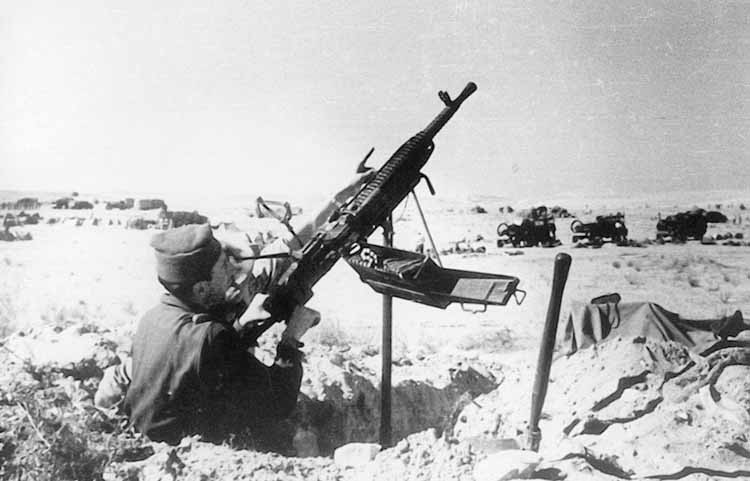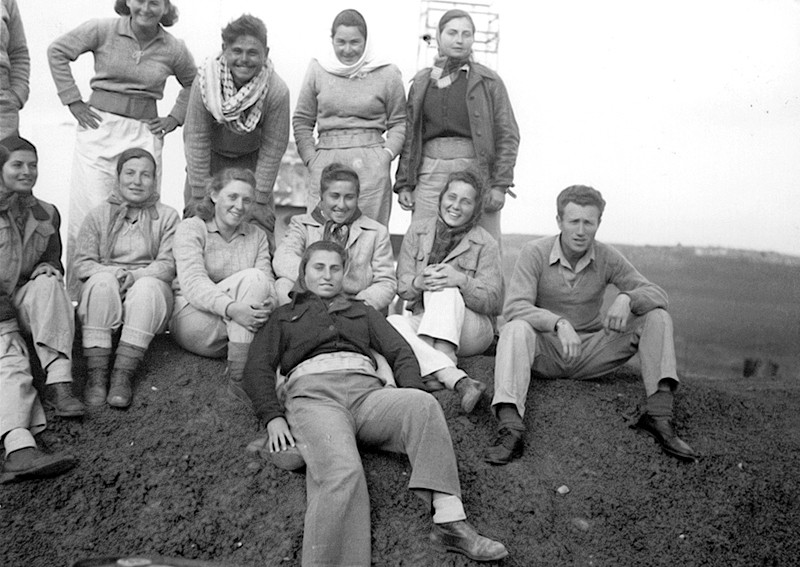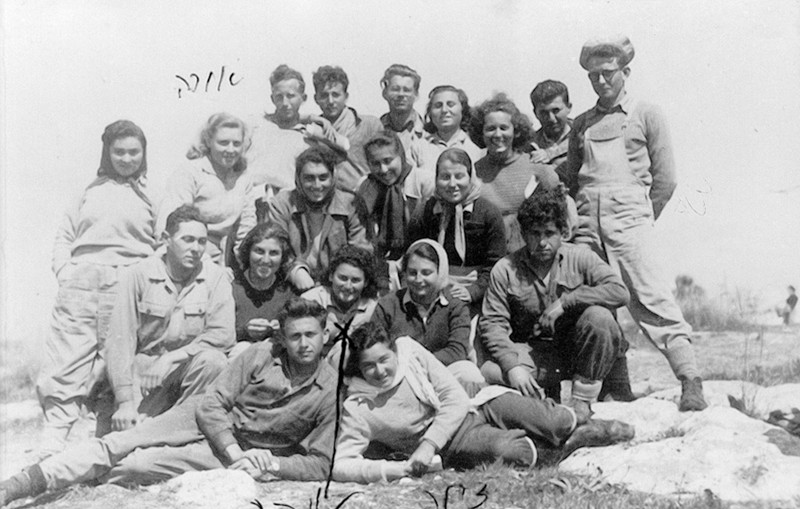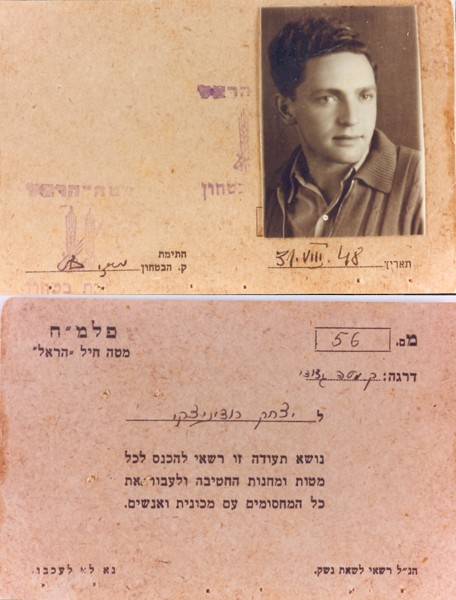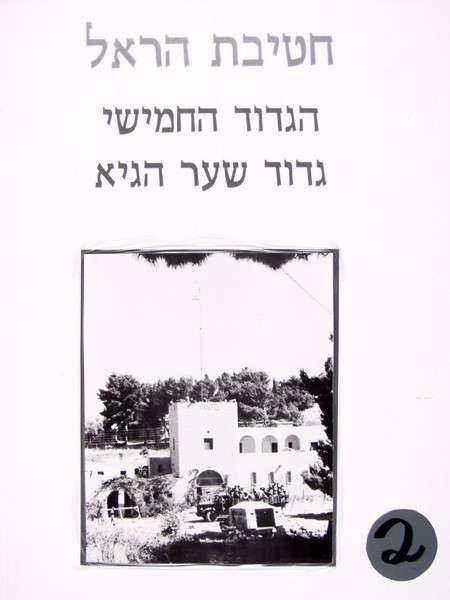The Fifth Battalion – the Sha'ar Hagai Battalion (Hare’l Brigade)
The Fifth Battalion began its formation in December 1947 on the basis of forces from the Tel Aviv Reserve forces, Hish (field combat crops) soldiers, new recruits and a small number of recruited training cadets, a process which was completed in January 1948.
Harel Brigade - The Fifth Battalion - 2
Harel Brigade - The Fifth Battalion - 4
The Fifth Battalion’s formation process lasted from December, 1947 until January, 1948, right after the United Nation’s decision to divide the country, on the basis of forces from the Tel Aviv Reserve forces, Hish (field combat crops) soldiers, new recruits from the towns and settlements, volunteers from the Moshavs (cooperative settlement) and Kibbutzs, as well as a small number of recruited training cadets from the pioneer youth movement’s and a former battalion under the command of Nahum Ariely, which was operating previously, escorting convoys from Tel Aviv to Jerusalem and to the Negev.
Up to April, 1948, the battalion operated in the surroundings of the road leading from the Shfela (lowlands) to Jerusalem, mainly escorting and securing convoys headed towards the besieged city which were exposed to attacks of Arab gangs, and executing retaliation operations. One of its companies camped in Giva’at Brener, a second one, in Giva’at Hashlosha, a third (named Zehavi), which engaged in convoy’s escort, in the main bus station in Tel Aviv and a fourth camped in Holon and in Mikve Israel and operated to take control of side- road posts [such as the Keren Hakayemet (National Fund) House] and attacked Arab Villages which hassled the convoys heading to Jerusalem and the Negev. Towards the end of February the company moved to Hulda and operated in its surroundings. Towards Operation Nahashon the company ascended to Kiryat Anavim and was annexed there to the Forth Battalion’s headquarters.
The battalion’s main object was to fight over the safety of the transportation routs and of the single road there was then to Jerusalem and to enable the conveyance of vital supplies such as food, fuel, security equipment and men, to the besieged city. Male and female fighters from the Battalion escorted and protected many dozens of convoys which were attacked on their way from Tel Aviv – Jaffa to Jerusalem.
During this period the battalion executed retaliation operations against the Arab Villages of Yazur, Bet Dagan, the Arab Hulda, Bet Jiz, Kubab, Bet Nekufa and Haqastel, as well as attacks on Arab vehicles which made use of the same roads. They broke through road blockades under fire, an action which many times resulted in hostile encounters with the British army’s units which confiscated the few weapons that they had.
For months the battalion protected the House of the Keren Kayemet which dominated the Jaffa- Ramala road, against the repeated Arab attacks which even involved casting barrels full of explosive on the building. The House was destroyed, but the important post remained in the Palmach’s hands. In March 1948, the battalion’s units participated in the attack on Saris, in the battle of the convoy to Gush- Etzion (Nabi Daniel convoy), and in the defense battle on the Hulda convoy. The battle on the Qastel on the 8th of April caused the Fifth Battalion eighteen fatalities and the Jerusalem Field Combat Crops, twenty one. On the 20th of April, in the framework of Operation Hare'l, all the battalion’s units rode up in trucks to Jerusalem. Hashayara Hagdola (the great convoy, also named Hare'l's convoy after the commanding force) included three hundred vehicles, amongst them the commanders of Hare'l Brigade, David Ben Gurion and the directorship of the Sochnut (the Zionist agency). The convoy was attacked and many of its participants were injured.
A total of 245 convoys comprising of 3100 trucks carrying 10,800 tons of provisions managed to reach Jerusalem – supplying 90 percent of the city’s minimal necessary consumption. The war of the convoys cost the lives of dozens of the battalion’s fighters and injured many. On the 21st of April, Operation Yevusi began in Jerusalem which was under the threat of conquest, and the battalion engaged in fighting in its neighborhoods and surroundings. Amongst their important operations were:
- The conquest and destruction of the village Sho’afat on the 23rd of April.
- The conquest of Sheikh Jarach neighborhood on the 25th, which had to be deserted because of the British army’s threat.
- The attack of the Iraqi force which besieged the Convent of Sun Simon and aiding the attack to conquer Qatamon on the 30th.
- The raiding and sabotaging of the Jerusalem – Jericho road by two of the battalion’s platoons in the beginning of May; after the raid the battalion attacked the fortified area of Augusta – Victoria situated on Mount Hazietim, and although the attack failed it managed to confine the Arab- Jordanian Legion’s forces to the spot and to clear the road to the University and the Hadasa Hospital situated on Mount Hazietim. These operations have in fact removed the northern Arab threat to the city.
In the middle of May the battalion re-conquered Kibbutz Ramat Rachel which previously fell in Egyptian, Iraqi and local Arabian hands, thus removing the southern Arab threat to the city.
- On the 1st of June the battalion’s unit, alongside a unit from the Forth Battalion and of the Jerusalem Field Combat Forces, attacked the high radar post which controlled the road close to Jerusalem, but the area was not conquered.
- In the course of the previous Operation Makabi whose goal was to clear the eastern section of the road to Jerusalem, the Battalion’s units fought for six straight days, starting from the 8th of May, on Sha’ar Hagai (Bab- El- Wad), until the conquest of all the posts controlling the most dangerous section of the road, which opened it back for traffic.
- On the 10th of June (Operation Yoram) the Fifth Battalion attacked the Latrun posts held by the Arab – Jordanian Legion, and blocked the road to Jerusalem. The central fortified post was conquered in the course of the fierce battle and caused many casualties (eighteen dead), but the Third Battalion that was supposed to join the battle did not arrive and the dawn was rising, and the counter attack forced the Battalion’s men to retreat. Although the road was not cleared, the Legion was confined to the place and the bypass road, Derech Burma (Burma Road) was made suitable for traffic.
During the first ceasefire on the 10th of July, the battalion’s men, for the first time in six months of fighting which included eighty operations, descended from Jerusalem to Israel Camp in the Shfela.
In the framework of Operation Dani and after it, during July and August, the battalion’s units participated in the battles of Bet Nuba, Abu- Lachem, Hirbat Luz and Kasla. Next, the battalion participated in Operation Hahar (the mountain), which meant to expand the passageway to Jerusalem and open a new path to the Negev. In the course of this operation, Beit Shemesh (the common post), and the villages of the Judea plains: Zaharia, Beit Natif, Dir-A-Sheikh, Beit Atav, Jersh, and Kfar Husan situated on Gush Etzion road and Bet Lechem, were conquered from the Egyptians.
Operation Horev, which took place from the 26th of December till the 6th of January, was the last operation during the war which involved a large number of participants. The battalion participated in the conquest of Auza El Hafir on the border of Sinai, from the Egyptian army, as well as penetrated Sinai itself. After this, on the evening of the cease fire, two companies took control of the Rafah posts but had to retreat under fire from the Egyptian counter attack because the armored battalion of the Eights Brigade did not arrive as planned.
Right after the conquest of Eilat on March 1949, the battalion spread out in the Arava and secured for three months the single unpaved road along the border line with Jordan.
The battalion’s commanders were: Shaul Yafe, Menachem Rusek, Isaschar (Isca) Shdami and Moshe (Moris) Ben Dror. Four company commanders lost their lives in action.
The Fifth Battalion, which was hastily set up just at the outbreak of the war, was very much different from the rest of the Palmach’s battalions in that it was assembled from a random collection of the Reserve men, such as recruited training cadets and individual fighters, and did not receive early training and organization. Its commanders did not get to know their men prior to the war, during which hundreds of new immigrants and homeless holocaust survivors joined the battalion. They rapidly integrated within the battalion’s units, studied Hebrew as they fought along and acquired the spirit and experience of the Palmach.
The battalion was popular in its nature, its men getting stronger as the war progressed. During the months of fighting in Jerusalem and its surroundings the men suffered from lack of adequate clothing and food, of fatigue and continuous stay under fire, but they were the saviors of Jerusalem, and as Bene Marshk, the Brigade’s Cultural officer remarked:” Through out the whole military history we have not seen another military unit whose front was limited to the width of a road, and this limited front was the one to determine the state’s fate.” And we all remember Shim’om Alfasy’s last order before he fell in the battle on the Qastel: “Privates retreat, commander remain and cover from the rear”.
The battalion participated in one hundred tough battles, which extremely wore its men out. Some one hundred and twenty men fell in the battles; many more were injured. Yiga’al Alon, then commander of the Palmach said: “The blood of Hare'l’s battalions was shed more than any other battalion of the Palmach, and they were put to the test, body and soul, suffering the hardships of war like no other unit suffered”.
Up to April, 1948, the battalion operated in the surroundings of the road leading from the Shfela (lowlands) to Jerusalem, mainly escorting and securing convoys headed towards the besieged city which were exposed to attacks of Arab gangs, and executing retaliation operations. One of its companies camped in Giva’at Brener, a second one, in Giva’at Hashlosha, a third (named Zehavi), which engaged in convoy’s escort, in the main bus station in Tel Aviv and a fourth camped in Holon and in Mikve Israel and operated to take control of side- road posts [such as the Keren Hakayemet (National Fund) House] and attacked Arab Villages which hassled the convoys heading to Jerusalem and the Negev. Towards the end of February the company moved to Hulda and operated in its surroundings. Towards Operation Nahashon the company ascended to Kiryat Anavim and was annexed there to the Forth Battalion’s headquarters.
The battalion’s main object was to fight over the safety of the transportation routs and of the single road there was then to Jerusalem and to enable the conveyance of vital supplies such as food, fuel, security equipment and men, to the besieged city. Male and female fighters from the Battalion escorted and protected many dozens of convoys which were attacked on their way from Tel Aviv – Jaffa to Jerusalem.
During this period the battalion executed retaliation operations against the Arab Villages of Yazur, Bet Dagan, the Arab Hulda, Bet Jiz, Kubab, Bet Nekufa and Haqastel, as well as attacks on Arab vehicles which made use of the same roads. They broke through road blockades under fire, an action which many times resulted in hostile encounters with the British army’s units which confiscated the few weapons that they had.
For months the battalion protected the House of the Keren Kayemet which dominated the Jaffa- Ramala road, against the repeated Arab attacks which even involved casting barrels full of explosive on the building. The House was destroyed, but the important post remained in the Palmach’s hands. In March 1948, the battalion’s units participated in the attack on Saris, in the battle of the convoy to Gush- Etzion (Nabi Daniel convoy), and in the defense battle on the Hulda convoy. The battle on the Qastel on the 8th of April caused the Fifth Battalion eighteen fatalities and the Jerusalem Field Combat Crops, twenty one. On the 20th of April, in the framework of Operation Hare'l, all the battalion’s units rode up in trucks to Jerusalem. Hashayara Hagdola (the great convoy, also named Hare'l's convoy after the commanding force) included three hundred vehicles, amongst them the commanders of Hare'l Brigade, David Ben Gurion and the directorship of the Sochnut (the Zionist agency). The convoy was attacked and many of its participants were injured.
A total of 245 convoys comprising of 3100 trucks carrying 10,800 tons of provisions managed to reach Jerusalem – supplying 90 percent of the city’s minimal necessary consumption. The war of the convoys cost the lives of dozens of the battalion’s fighters and injured many. On the 21st of April, Operation Yevusi began in Jerusalem which was under the threat of conquest, and the battalion engaged in fighting in its neighborhoods and surroundings. Amongst their important operations were:
- The conquest and destruction of the village Sho’afat on the 23rd of April.
- The conquest of Sheikh Jarach neighborhood on the 25th, which had to be deserted because of the British army’s threat.
- The attack of the Iraqi force which besieged the Convent of Sun Simon and aiding the attack to conquer Qatamon on the 30th.
- The raiding and sabotaging of the Jerusalem – Jericho road by two of the battalion’s platoons in the beginning of May; after the raid the battalion attacked the fortified area of Augusta – Victoria situated on Mount Hazietim, and although the attack failed it managed to confine the Arab- Jordanian Legion’s forces to the spot and to clear the road to the University and the Hadasa Hospital situated on Mount Hazietim. These operations have in fact removed the northern Arab threat to the city.
In the middle of May the battalion re-conquered Kibbutz Ramat Rachel which previously fell in Egyptian, Iraqi and local Arabian hands, thus removing the southern Arab threat to the city.
- On the 1st of June the battalion’s unit, alongside a unit from the Forth Battalion and of the Jerusalem Field Combat Forces, attacked the high radar post which controlled the road close to Jerusalem, but the area was not conquered.
- In the course of the previous Operation Makabi whose goal was to clear the eastern section of the road to Jerusalem, the Battalion’s units fought for six straight days, starting from the 8th of May, on Sha’ar Hagai (Bab- El- Wad), until the conquest of all the posts controlling the most dangerous section of the road, which opened it back for traffic.
- On the 10th of June (Operation Yoram) the Fifth Battalion attacked the Latrun posts held by the Arab – Jordanian Legion, and blocked the road to Jerusalem. The central fortified post was conquered in the course of the fierce battle and caused many casualties (eighteen dead), but the Third Battalion that was supposed to join the battle did not arrive and the dawn was rising, and the counter attack forced the Battalion’s men to retreat. Although the road was not cleared, the Legion was confined to the place and the bypass road, Derech Burma (Burma Road) was made suitable for traffic.
During the first ceasefire on the 10th of July, the battalion’s men, for the first time in six months of fighting which included eighty operations, descended from Jerusalem to Israel Camp in the Shfela.
In the framework of Operation Dani and after it, during July and August, the battalion’s units participated in the battles of Bet Nuba, Abu- Lachem, Hirbat Luz and Kasla. Next, the battalion participated in Operation Hahar (the mountain), which meant to expand the passageway to Jerusalem and open a new path to the Negev. In the course of this operation, Beit Shemesh (the common post), and the villages of the Judea plains: Zaharia, Beit Natif, Dir-A-Sheikh, Beit Atav, Jersh, and Kfar Husan situated on Gush Etzion road and Bet Lechem, were conquered from the Egyptians.
Operation Horev, which took place from the 26th of December till the 6th of January, was the last operation during the war which involved a large number of participants. The battalion participated in the conquest of Auza El Hafir on the border of Sinai, from the Egyptian army, as well as penetrated Sinai itself. After this, on the evening of the cease fire, two companies took control of the Rafah posts but had to retreat under fire from the Egyptian counter attack because the armored battalion of the Eights Brigade did not arrive as planned.
Right after the conquest of Eilat on March 1949, the battalion spread out in the Arava and secured for three months the single unpaved road along the border line with Jordan.
The battalion’s commanders were: Shaul Yafe, Menachem Rusek, Isaschar (Isca) Shdami and Moshe (Moris) Ben Dror. Four company commanders lost their lives in action.
The Fifth Battalion, which was hastily set up just at the outbreak of the war, was very much different from the rest of the Palmach’s battalions in that it was assembled from a random collection of the Reserve men, such as recruited training cadets and individual fighters, and did not receive early training and organization. Its commanders did not get to know their men prior to the war, during which hundreds of new immigrants and homeless holocaust survivors joined the battalion. They rapidly integrated within the battalion’s units, studied Hebrew as they fought along and acquired the spirit and experience of the Palmach.
The battalion was popular in its nature, its men getting stronger as the war progressed. During the months of fighting in Jerusalem and its surroundings the men suffered from lack of adequate clothing and food, of fatigue and continuous stay under fire, but they were the saviors of Jerusalem, and as Bene Marshk, the Brigade’s Cultural officer remarked:” Through out the whole military history we have not seen another military unit whose front was limited to the width of a road, and this limited front was the one to determine the state’s fate.” And we all remember Shim’om Alfasy’s last order before he fell in the battle on the Qastel: “Privates retreat, commander remain and cover from the rear”.
The battalion participated in one hundred tough battles, which extremely wore its men out. Some one hundred and twenty men fell in the battles; many more were injured. Yiga’al Alon, then commander of the Palmach said: “The blood of Hare'l’s battalions was shed more than any other battalion of the Palmach, and they were put to the test, body and soul, suffering the hardships of war like no other unit suffered”.


















